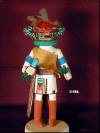 |
C1BL
- 12" Bear
Katsina
by Barbara Talahytewa.
The bear katsina appears alone or in a group. He is known to have special
healing powers. The bear katsina is of such great strength that it is felt
he can cure the sick. |
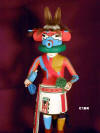 |
C1BR
- 13" Nuvak' China or Snow
Katsina
by E. Talahytewa.
The Snow Katsina appears in many Hopi dances such as the Powamu, Kiva
Dances, Water Serpent Ceremony, and Mixed Katsina Dances. Presumably he
lives on top the San Francisco Peaks and helps to bring the cold and the
snows of winter to the Hopi. |
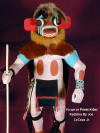 |
C1TC
- 16" Yo-we or Priest Killer Katsina
By Joe LaCapa Jr.
In the late 1600's the Hopis rebelled against the Spanish priests at the
same time as the Pueblos along the Rio Grande, but in contrast to the
eastern group the Hopis were never reconquered. Yo-we is thought to be the
Katsina that killed the priest at Oraibi during the revolt. He grabbed for
the priest's girl friend but succeeded only in tearing off one Earring's,
which is why this Katsina always appears with a single earring. |
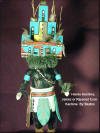 |
C1TL
- 15" Hemis Katsina, Jemez or Ripened Corn Katsina.
By Skaten
The Hemis Katsina is most often used for the Niman or Home-Going Ceremony
when the Katsinas leave for six months. It is one of the most appropriate
Katsinas for this farewell as it is the first Katsina to bring mature corn
to the people, indicating that the corn crop is assured. |
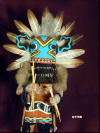 |
C1TR
- 14" Wuayk-Kuita, Broad Face Katsina (Guard Katsina)
by Artist Poleyeapuma
The Broad-Face Katsina is the most typical form of guard, as he appears in
the Bean Dance on all three mesas. On First Mesa he comes with Soyoko
during the Powamu, while on the Second and Third he guards the procession
during Bean Dance Ceremony. He brings up the rear and keeps everyone
moving forward together. |
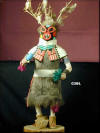 |
C2BL
- 12" Masau'u or Ghost Katsina, Earth God Katsina (has a short note
written by the artist about the Katsina between the legs. With the artist
name & address.) By Stacy Talahytewa.
Stacy Talahytewa provided
the family income by selling his carved dolls. He carves arms and legs
separately, glues them to the body of the carved doll and adorns the heads
with chicken or turkey feathers. He inspired his children who have become
Kachina carvers also. Masau'u is
the deity who controls both the surface of the earth and the Underworld.
In his capacity as ruler of the of the earth, he gave the Hopi their lands
and bade them honor him with prayer plumes when they traveled the land. as
god of death he controls the passage of the dead into the Underworld and
the movement of Katsinas emerging from the netherland into the world of
living through the kivas.. |
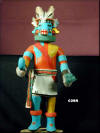 |
C2BR
- 12" Omau'u Katsina, Cloud Katsina
By Paul F. Coochyamptewa.
The Omau'u Katsina formerly appeared in the Mixed Dances. For some reason
this Katsina has dropped in popularity since the part of this century and
is now virtually uknown. the doll appears only in the older collections.
|
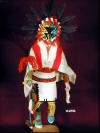 |
C2TC
- 14" Ahola Katsina By Albert Silas.
Ahola Katsina is an important chief Katsina for both the First and Second
Mesa as he opens the Powamu ceremony with Kiva performance on the first
night. This performance seems to involve mimetic magic to slow the passage
of the sun. At a shrine in the "Gap" of the First Mesa the next day an
additional rite is performed as the sun rises. With daybreak Ahul (or
Ahola) and Powamu Chief deposit pahos (prayer feathers) at Katsina spring,
for he is the ancient one of the Katsina Clan. |
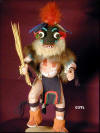 |
C2TL
- 13" Nuvak' China or Snow Katsina
by E. Talahytewa.
The Snow Katsina appears in many Hopi dances such as the Powamu, Kiva
Dances, Water Serpent Ceremony, and Mixed Katsina Dances. Presumably he
lives on top the San Francisco Peaks and helps to bring the cold and the
snows of winter to the Hopi. |
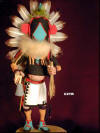 |
C2TR
- 13" Nangasohu Katsina, Chasing Star or Meteor Katsina
By George E. Pooley.
According to some Hopi this Katsina represents a planet but to many others
it is a meteor that is the Chasing Star. The Katsina wears an enormous
head dress of trailing eagle feathers, carries a yucca whip and a bell and
appears in pairs. |
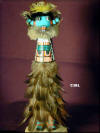 |
C3BL
- SOLD sorry |
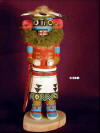 |
C3BR
- 8" Omau'u Katsina, Cloud Katsina
By Lyle Lomayma .
The Omau'u Katsina formerly appeared in the Mixed Dances. For some reason
this Katsina has dropped in popularity since the part of this century and
is now virtually unknown. the doll appears only in the older collections.
|
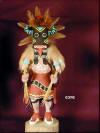 |
C3TC
- 12" Hu', Tungwup, Whipper Katsina
By George E. Pooley.
The Hu' Katsinas appear before the actual Bean Dance Parade to initiate
the children into the Katsina Cult. They always come as a pair and
accompany the Crow Mother who holds their whips for them. As each child is
brought forward to stand before them they strike four solid blows across
their backs with the yucca whips, taking turns at the task until all have
received this treatment. |
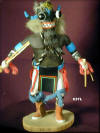 |
C3TL
- 10" Hu', Tungwup, Whipper Katsina
By Augustine Komolestewa .
The Hu' Katsinas appear before the actual Bean Dance Parade to initiate
the children into the Katsina Cult. They always come as a pair and
accompany the Crow Mother who holds their whips for them. As each child is
brought forward to stand before them they strike four solid blows across
their backs with the yucca whips, taking turns at the task until all have
received this treatment. |
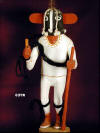 |
C3TR
- 12" Kokopelli Hump-backed Flute Player "Kokopolo" By R. S. Pentewa
"1976".
This is one of the most popular and best known of all the Hopi Katsina
dolls. He is also one of the most easily recognized because of the hump on
his back. His black mask has whit pot hook eyes and a whit stripe painted
over the top. A conical beak pointing up gives him a definite phallic
appearance. In real life, the bill or beak is made of twisted corn
Kokopelli Hump-backed Flute Player "Kokopolo"n husks. |
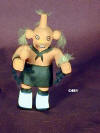 |
C4B1
- 3 1/2" Mudhead, Koyemsi Katsina By Skalon.
The Koyemsi is a multi-faceted clown introduce form the Zuni. the may
appear as a chorus, and on First Mesa and possibly other villages their
songs are in Zuni. During the rest of the in a dance they may engage in
games with the boys and girls in the audience. At other times only a
single Mudhead may appear as drummer for a group. |
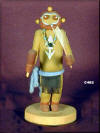 |
C4B2
- 4" Mudhead Koyemsi by Unknown The Mudhead is a multi-faceted clown
introduce from the Zuni. The Mudhead may appear as a chorus, and on First
Mesa and possibly other villages, their songs are in Zuni. During the rest
of the dance they may engage in games with the boys and girls in the
audience. At other times only a single Mudhead may appear as drummer for a
group. |
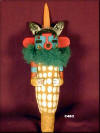 |
C4B3
- 8" Corn Katsina By E Pooley.
Corn Katsina's are the most common of the plant impersonators. This tihu
is covered with spots that represent kernels of corn. The Corn Katsina
appear during winter kiva dances and springtime plaza dances. Several
types of Corn Katsina represent the different varieties of corn given as
presents during during performances. |
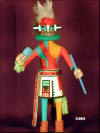 |
C4B4
- 8" Honan, Badger Katsina By Stacy Talahytewa.
Stacy Talahytewa
provided the family income by selling his carved dolls. He carves arms and
legs separately, glues them to the body of the carved doll and adorns the
heads with chicken or turkey feathers. He inspired his children who have
become Kachina carvers also.
The Honan or Badger Katsina is more often seen during the Mixed Dances on
Third Mesa or the Water Serpent Ceremony on First Mesa than during the
Powamu. |
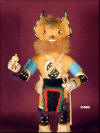 |
C4B5
- 7" Kona or Chipmunk Katsina By O. Jackson.
The Chipmunk carries yucca whips with which to urge onward anyone who
races against him. Should thy win he gives them prizes of yellow and red
piki bread. |
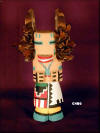 |
C4B6
- 8" Lagan or Squirrel Katsina By George Pooley.
The Squirrel Katsina appears on all three mesas but has two rather
distinct forms. During the Kiva Dances in winter he is supposed to
challenge any woman to take from him anything that she thinks worth
having. |
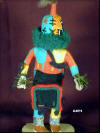 |
C4T1
- 8" Aya, or Tuskiapaya, Rattle or Crazy Rattle Runner Katsina By Elidia
Chapella
The Crazy Rattle Runner carry yucca which they use on any race who loses,
to give several hard swats. If, however, the man should win, he will be
given piki bread. |
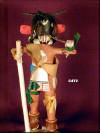 |
C4T2
- 8" Awatovi Ogre Man Katsina By W. M. Bill Satala The ogre is an
important from the village of Awatovi, destroyed early in the 1700s and
the survivors taken to the Hopi villages of today. the Awatovi Soyok' Taka
behaves almost exactly like the Wiharu or White Nataska and is probably a
variant of that Katsina. The Soyok' Taka stands at the side during the
ordeal of the children, stamping and grumbling, with a large basket ready
and waiting on its back. |
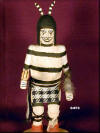 |
C4T3
- 8" Koshari Clown Katsina, Paiyakyamu, Hano Clown, Glutton By No Artist
Available
The multiple names of this clown give some indication of his origin.
Koshari or variants of them may be found in most of the pueblos. They are
figures that are both sacred and profane. Their actions while highly
amusing are not what the Hopi or anyone else would like to be caught doing
in public. |
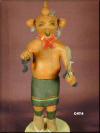 |
C4T4
- 8" Mudhead, Koyemsi Katsina
By Lyle Lomayma. "1986"
The Koyemsi is a multi-faceted clown introduce form the Zuni. the may
appear as a chorus, and on First Mesa and possibly other villages their
songs are in Zuni. During the rest of the in a dance they may engage in
games with the boys and girls in the audience. At other times only a
single Mudhead may appear as drummer for a group. |
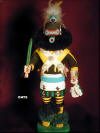 |
C4T5
- 9" Sipikne, many other names, Zuni Warrior Katsina By Elidia Chapella .
This Katsina, an import from Zuni, is undergoing a gradual transformation
into a more Hopi form of Katsina through slight innovations which change
the original figure. Formerly the sipikne came with not rattles at all and
danced furiously in complete silence, but of recent sleigh bell have been
added to his costume. He comes in all of directional colors and is a
favorite of the Katsina Carvers. |
